

Zia symbol. Native American Children and Families in New Mexico: Strengths and Challenges – New Mexico Voices for Children. Snapshots from the American Community Survey and Other Data Sources A New Mexico KIDS COUNT 2012 Special Report Download the full report (Dec. 2012; 58 pages; pdf) Find more data for New Mexico and the nation here Introduction by Christine Hollis, MPH, MPS Native Americans make up just 1.7 percent of the United States population.
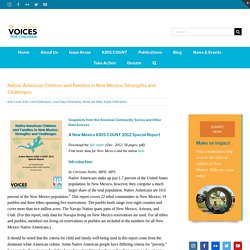
In New Mexico, however, they comprise a much larger share of the total population. File:Locationoftesuque.JPG - SantaFedia. List of Indian reservations in New Mexico. From Wikipedia, the free encyclopedia Jump to navigationJump to search This is a list of Indian reservations and Pueblos in the U.S. state of New Mexico.
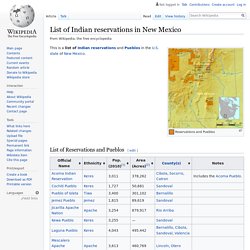
NEW MEXICO Indian tribes: BIA contact info, web links. Jacob Viarrial, GovernorPueblo of PojoaqueRoute 11, Box 71Santa Fe, NM 87501P: 505/455-2278F: 505/455-2950(Northern Pueblos)[back to index] Pojoaque Pueblo Info --from the Pueblo Cultural Center page Alex Lujan, GovernorPueblo of SandiaP.O.
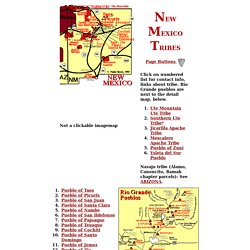
Box 6008Bernalillo, NM 87004P: 505/867-3317F: 505/867-9235(Southern Pueblos)[back to index] Sandia Pueblo info prepared by the pueblo. The Sandia Pueblo -- from the Pueblo Cultural Center page Lawrence Troncosa, GovernorPueblo of San FelipeP.O. The San Felipe Pueblo -- from the Pueblo Cultural Center page Elmer C. The San Ildefonso Pueblo -- from the Pueblo Cultural Center page Earl Salazar, GovernorPueblo of San JuanP.O. Internet Community Wiki. North American Chapters Workshop - 2018 - Internet Community Wiki. The 2018 North America Chapters Workshop was held on July 28 in Washington, DC and attended by chapter leaders, ISOC staff, consultants and a facilitator.
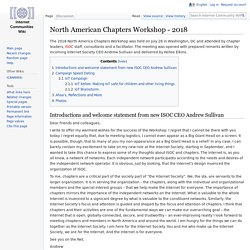
The meeting was opened with prepared remarks written by incoming Internet Society CEO Andrew Sullivan and delivered by Kellee Elkins. Introductions and welcome statement from new ISOC CEO Andrew Sullivan Dear friends and colleagues, I write to offer my warmest wishes for the success of the Workshop. I regret that I cannot be there with you today. To me, chapters are a critical part of the society part of “the Internet Society”. See you on the Net, Andrew Campaign Speed Dating.
E-Rate. E-Rate is the commonly used name for the Schools and Libraries Program of the Universal Service Fund, which is administered by the Universal Service Administrative Company (USAC) under the direction of the Federal Communications Commission (FCC).
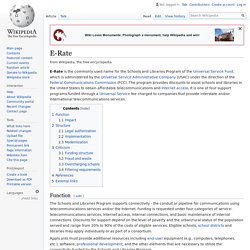
The program provides discounts to assist schools and libraries in the United States to obtain affordable telecommunications and Internet access. It is one of four support programs funded through a Universal Service fee charged to companies that provide interstate and/or international telecommunications services. Function[edit] E-Rate Program - Discounted Telecommunications Services. The Universal Service Administrative Company (USAC) is an independent, not-for-profit corporation created in 1997 to collect universal service contributions from telecommunications carriers and administer universal support mechanisms (programs) designed to help communities across the country secure access to affordable telecommunications services.

USAC carries out its functions as the administrator of the federal universal service programs and Universal Service Fund (USF) under the oversight of the Federal Communications Commission (FCC). USAC administers universal service programs for high cost companies in rural areas, low-income consumers, rural health care providers, and schools and libraries. The universal service Schools and Libraries Program, commonly known as “E-rate,” provides discounts of up to 90 percent to help eligible schools and libraries in the United States obtain affordable telecommunications and internet access. Eligibility Further Information.
Community broadband networks. A recent series of in-depth articles from Education Week brings to light a persistent aspect of the digital divide: the lack of fast, affordable, reliable connectivity in rural schools.
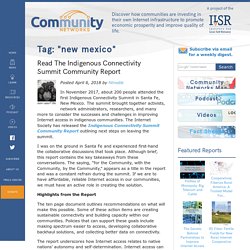
Throughout the country, schools struggle to pay exorbitant fees for aging copper networks. Teachers and students are cut off from digital learning opportunities as whole regions fall farther behind. Education Week brings these issues to the forefront - and community-owned institutional networks could be the answer. The Education Week articles describes the harsh impact of these grim statistics. The nonprofit EducationSuperHighway found that for rural schools, the median price for connectivity is more than double that of urban or even suburban schools.
In extremely rural communities, large service providers do not have an incentive to build high-speed networks, and small private providers often cannot take on those high upfront costs. Community broadband networks. Mapping. NOTE: We are working diligently to collect and process data for the upcoming 2018 Co-Location Report.
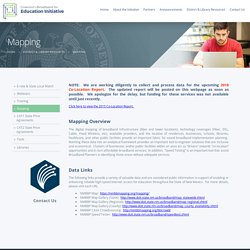
The updated report will be posted on this webpage as soon as possible. We apologize for the delay, but funding for these services was not available until just recently. Mapping Overview The digital mapping of broadband infrastructure (fiber and tower locations), technology coverages (Fiber, DSL, Cable, Fixed Wireless, etc), available providers, and the location of residences, businesses, schools, libraries, healthcare, and other public facilities provide an important fabric for sound broadband implementation planning.
Mashing these data into an analytical framework provides an important tool to engineer solutions that are inclusive and economical. Data Links The following links provide a variety of valuable data and are considered public information in support of enabling or enhancing reliable high-speed Internet access for education throughout the State of New Mexico. New Mexico Broadband Map. Zia people. The Zia /ˈziːə/ are an indigenous tribe centered at Zia Pueblo, an Indian reservation in the U.S. state of New Mexico.

The Zia are known for their pottery and use of the sun symbol. The people are a branch of the Pueblo community.[3] History[edit] Mutually Agreed Norms for Routing Security. Accept Donations online for nonprofit fundraising. Chapters. Working together in Internet Society Chapters, our members help us further our cause to achieve an open and free Internet – an Internet for everyone.
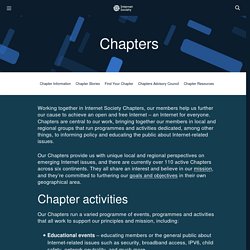
Chapters are central to our work, bringing together our members in local and regional groups that run programmes and activities dedicated, among other things, to informing policy and educating the public about Internet-related issues. Our Chapters provide us with unique local and regional perspectives on emerging Internet issues, and there are currently over 110 active Chapters across six continents. They all share an interest and believe in our mission, and they’re committed to furthering our goals and objectives in their own geographical area.
Chapter activities. Home. Application Form. How do I do this? 1 Create a ZoomGrants™ account (below) or log in to your existing account (above) 2 Select a Program to apply for, then click the Apply button to get started 3 Answer the questions and/or fill in the fields in each tab 4 If necessary, upload any requested documents 5 Submit your application and wait for a decision 6 If you are selected to receive funding, you might be required to submit invoices or reports through your application Answers are saved automatically when you leave each field. Turn SPELL-CHECKING on. Your browser probably has it, might as well use it. Copying/pasting data works best when you are pasting UNFORMATTED text. Search. Search. Search. Navajo Nation. NNDIT - Network. Services Description The Department of Information Technology's (DIT) Network Section is responsible for maintaining the Email System and Internet Services for the Navajo Nation Government, which includes the following: Troubleshooting network issues Make changes / additions to network equipment Maintain wide area networks and local area networks such as: Dial-up line from Window Rock and five agencies ( Tuba City , Kayenta, Shiprock, Crownpoint, and Chinle).
Lease line for National Crime Information Center for Law Enforcement's seven districts. Setup WiFi wireless equipment: access point inside DIT and building to building connectivity. Local area gigabit backbone in Window Rock. DIT's Network section is also responsible for the setup and maintenance of various network servers. DIT's Network section manages an email server, anti-virus server, authentication server, web server, several tribal department servers, internal DNS / AD / DHCP / WINS server, and an external DNS server.
Library - Santo Domingo Pueblo. Eventbrite Pricing and Features for Organizers. Eventbrite. 1st-mile-nm Info Page.